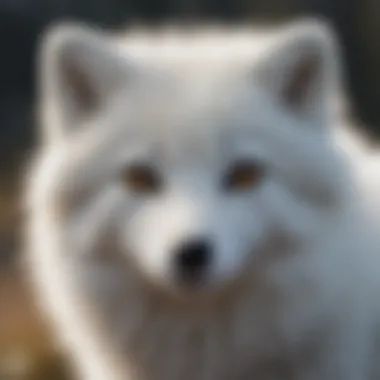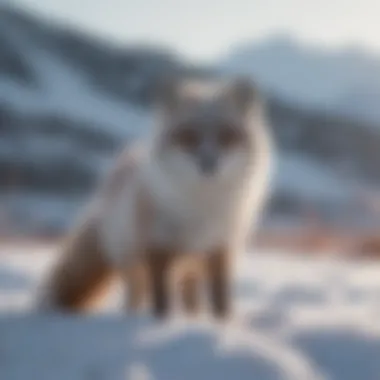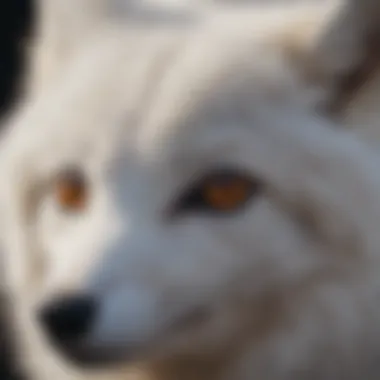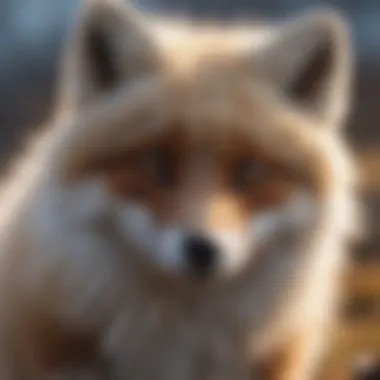Exploring the Color Palette of Arctic Foxes


Nature Topic Overview
Arctic foxes are remarkable animals found in the icy landscapes of the Arctic. What sets them apart is not just their small size or fluffy tails, but their stunning array of colors. They can adapt their fur colors based on the seasons and surroundings, which is essential for survival in harsh conditions. This article explores these color variations and explains how they serve as adaptations to their environment and the changing climate.
Understanding the color palette of Arctic foxes involves looking at various aspects. First, we can discuss the main color types, such as white, brown, and grey. Then, we will consider the biological reasons behind these colors. Finally, climate change's impact on these color variations is crucial in the modern world.
Fun Facts and Trivia
Everyone loves fun facts! Here are some engaging tidbits about Arctic foxes:
- Color Changes: In summer, their fur turns brown or grey to blend in with the rocks and plants. In winter, the fur changes to white for camouflage in a snowy setting.
- Thick Fur: Arctic foxes have some of the thickest fur of any mammal. It keeps them warm during freezing temperatures.
- Small Ears: They have short ears and a smaller body, which helps conserve heat.
These facts not only inform but also excite young learners about these creatures. Visual aids like pictures of Arctic foxes in different seasons can captivate the imagination.
Wildlife Explorations
Arctic foxes coexist with various species in the Arctic tundra. For instance, they compete with larger predators like polar bears for food. Despite this, their diet includes lemmings, birds, and occasionally carrion. The tundra is also home to fascinating plants like lichens and mosses. Exploring these species helps young readers understand the delicate balance of the Arctic ecosystem.
Environmental Awareness
With climate change affecting temperatures and habitats, understanding Arctic fox color variations becomes even more vital.
- Conservation Awareness: It is important to protect their habitat to ensure their survival. Educating children about these issues can instill a sense of responsibility for the environment.
- How to Help: Simple tips like recycling, saving electricity, and supporting wildlife protection organizations can make a difference. Children can participate in local clean-up days or conservation projects to see the impact of their efforts.
DIY Nature Activities
Engagement through hands-on activities can enhance learning about Arctic foxes. Here are some fun project ideas:
- Fur Color Changing Craft: Using colored paper, create a seasonal Arctic fox. Kids can cut out a template of a fox, coloring it white for winter and brown for summer.
- Nature Inspired Art: Collect natural items, like leaves or twigs, to create an Arctic landscape diorama featuring the fox and its environment.
- Outdoor Exploration: Go for walks to observe local wildlife. Encourage children to take notes or draw pictures of animals they see, relating them back to what they learn about Arctic foxes.
These activities offer a practical understanding of the subject while fostering connections to the natural world.
Intro to Arctic Fox Colors
The world of Arctic foxes is rich in nuances. Color variations in these animals are not just a beautiful sight but serve as a crucial aspect of their survival. In this article, we will explore how these color changes occur and why they matter. Understanding the colors of Arctic foxes involves more than just observing their fur; it encompasses a deep look into their biology, behavior, and environment. By learning about their color palette, we can appreciate their adaptation strategies in extreme conditions.
Understanding Arctic Foxes
Arctic foxes (Alopex lagopus) are small mammals found in the cold regions of the Arctic. They have thick fur, which keeps them warm in freezing temperatures. There are several striking features about their appearance. They have a small body, short muzzle, and bushy tail, making them well-suited for their habitat. The primary factor behind their fur colors is the variable climate they endure. From pure white during winter to different shades in the summer, their colors shift dramatically.
Their ability to adapt is fascinating. They have developed features over time to withstand harsh conditions and hunt efficiently. Understanding these animals provides insights about life in extreme environments, emphasizing how physical attributes correlate with survival.
Significance of Coloration
The coloration of Arctic foxes plays a vital role in their existence. Their fur changes seasonally, which is an evolutionary response to their environment. Here are some key points about the significance of their coloration:
- Camouflage: The white fur during winter helps them blend in with the snow. This quality is essential for avoiding predators and sneaking up on prey.
- Thermoregulation: The color of their fur can also affect body temperature. Lighter colors reflect sunlight, keeping them cooler during summer months when the snow melts.
- Social signaling: Fur color can communicate health and genetic fitness. Other foxes may assess potential mates based on color variations.
- Ecosystem impact: Changes in their coloration can indicate broader environmental shifts. This serves as a signal for ecological changes happening within their habitats.
Understanding Arctic fox colors provides valuable clues about the impacts of climate change.


In summary, colors are not just for show. They signify adaptation, survival, and ecological interaction. The Arctic fox embodies a perfect example of how animals adapt to their surroundings, highlighting the delicate balance of life in aggregate ecosystems.
Primary Color Variations
The color variations of Arctic foxes are essential to understanding their adaptations and survival strategies in harsh Arctic environments. Color not only impacts their camouflage, making them less visible to predators and prey, but also influences social interactions and mating habits. This section will expand on the primary color types, which are unique to these fascinating animals, and shed light on their biological and ecological significance.
White Arctic Fox
The White Arctic fox is perhaps the most recognized among its kin. Their pure white fur helps them blend seamlessly into the snowy landscapes, providing excellent camouflage during the winter months. This adaptation is critical for hunting small rodents and birds, as well as evading larger predators.
Interestingly, the White Arctic fox does not retain its striking white coat year-round. The fur is thick, soft, and provides insulation against extreme cold. In summer, these foxes molt, revealing a brown or grayish coat that helps them adapt to the tundra’s earthy patterns. This seasonal change is vital for maintaining effective camouflage in varying environments.
Seasonal Changes in Color
The Arctic fox exhibits notable seasonal changes in its fur color, which underscores the effects of climate on animal adaptations. In winter, the coats transform into a white hue, while in summer, they shift to shades of brown or gray. The timing of this molting is regulated by changes in daylight and temperature as seasons shift.
These color variations not only highlight the fox's adaptability to its environment but also serve as a study in how seasonal cues affect physiological changes. The white coat is perfect for the snowy, glacial backdrop, while the darker summer coat can provide better insulation against solar radiation as the snow melts.
"Seasonal shedding of fur is a remarkable example of how wildlife adapts to environmental changes."
Gray Arctic Fox
In contrast, the Gray Arctic fox, or the Arctic fox with a gray pigmentation, showcases another layer of adaptation to different habitats within Arctic regions. The gray fur offers a transitional form of camouflage, especially in areas where both vegetation and rocky landscapes are present. Unlike their white counterparts, these foxes may not be tied strictly to the ever-changing snow and ice environments.
The adaptability of the gray coloration illustrates the complexity of Arctic foxes. Their fur can range in hue from dark gray to nearly silver, enabling them to navigate various terrains effectively.
Cross Arctic Fox
The Cross Arctic fox is a fascinating variant that displays a combination of light and dark fur. Typically, these foxes have a mix of white and gray colors, appearing as if crossed between the White and Gray Arctic fox. This unique coloration can be advantageous in mixed environments, where patches of snow and earth coexist.
Much like the other variations, the Cross Arctic fox utilizes its distinctive color for camouflage and social signaling. Their striking appearance often attracts interest, allowing them to partake in successful mating displays. The combination of colors serves both the practical purpose of adaptation and the aesthetic uniqueness of this particular type.
Role of Environment in Coloration
Understanding how the environment plays a role in the coloration of Arctic foxes is key to grasping their survival strategies. The Arctic landscape is challenging, and these foxes have evolved to adapt to the conditions they face. Coloration is not just for beauty; it is a practical advantage. The changing seasons, the presence of snow, and the types of vegetation all influence the fur color of these animals.
Adaptive Camouflage
Adaptive camouflage is a crucial aspect for Arctic foxes. During winter, their fur becomes white, blending seamlessly with the snowy terrain. This adaptation helps them hide from predators and enhances their hunting success when chasing smaller animals like lemmings. In the summer, the foxes’ fur shifts to a brown or grayish hue. This color change allows them to better merge with the earth tones of their surroundings, such as rocks and soil. This ability to change color is not only fascinating but essential for their survival.
"Adaptation to local environments significantly improves their chances of survival by reducing visibility to both prey and predators."
Influence of Habitat
The specific habitats of Arctic foxes also dictate their color variations. Coastal areas might have different vegetation than inland tundra, influencing the dominant color of the fox’s fur. Areas with more rocky landscapes might see foxes with darker shades to match their environment. The availability of food sources can also impact how successful these foxes are. When the foxes migrate or inhabit different territories, they often experience changes in their coloration. This shows a direct response to their habitats, demonstrating how adaptable and resilient these creatures are in the face of environmental differences.
The interplay between an Arctic fox's coloration and its environment emphasizes the delicate balance of nature. Keeping these factors in mind allows us to better understand the survival tactics of Arctic foxes.
Genetic Factors Determining Color
Understanding the genetic factors that determine the color of Arctic foxes is essential. This knowledge helps explain how various hues and patterns arise in these animals and how they contribute to their survival in harsh climates. The Arctic fox exhibits a diverse range of colors, influenced largely by inheritance and specific pigmentation genes. By studying these aspects, we gain insight into the evolutionary adaptations of these unique creatures.


Inheritance Patterns
Inheritance patterns play a crucial role in the coloration of Arctic foxes. Just like humans, the fur color of Arctic foxes comes from genes inherited from their parents. To illustrate, two parent foxes pass down a combination of alleles, which are variations of a gene. This genetic mix can lead to a variety of outcomes in their offspring.
Some important points about inheritance include:
- Dominant and Recessive Genes: Some color traits are dominant, meaning they are more likely to show up in the offspring if one parent has that trait. Others are recessive, requiring both parents to contribute the gene for the trait to manifest.
- Color Variations in Offspring: Offspring can inherit different combinations of genes from their parents, leading to a range of colors. This genetic diversity is key to the adaptation of Arctic foxes to their environment.
- Effects of Inbreeding: Limited gene pools can lead to inbreeding, potentially reducing diversity in coloration and making populations more vulnerable to diseases.
Role of Pigmentation Genes
Pigmentation genes significantly influence the coloration of Arctic foxes. These genes dictate the type and amount of pigment produced in the fur. Two primary pigments involved are eumelanin (responsible for black and brown colors) and pheomelanin (which creates yellows and reds).
Key features of pigmentation genes include:
- Determining Base Color: The presence and interaction of various pigmentation genes can set the base color of the fur, such as white or gray.
- Fur Color Change in Seasons: Some pigmentation genes are even affected by the change in seasons. For instance, the Arctic fox has white fur in winter to blend into the snow-covered environment and gray or brown fur in summer.
- Environmental Influence: Gene expression can also be influenced by environmental factors, including temperature and light, showcasing how Arctic foxes adapt to their surroundings.
"The adaptation of Arctic fox colors is a fascinating example of how genetics and environment work together."
In summary, genetic factors play a pivotal role in the coloration of Arctic foxes. The interplay between inheritance patterns and pigmentation genes determines how these animals adapt to their environment and survive in the Arctic landscape.
Behavioral Aspects of Coloration
Understanding the behavioral aspects of coloration in Arctic foxes provides insight into their adaptation and survival strategies. Their fur colors are not just for show; they serve multiple practical purposes. The shades and patterns in their fur can affect their interactions with each other and their environment.
Mating and Color Preferences
Mating behaviors in Arctic foxes are influenced by coloration. Research shows that both male and female Arctic foxes may exhibit color preferences when selecting a mate. For example, the bright white fur of the female may attract males during the breeding season. This preference can be related to perceived health and genetic fitness. Males with more vibrant color variations might also show more interest in females with similarly striking coats.
Some studies indicate that the contrast in colors plays a role in courtship displays. A male's ability to stand out against the snowy background can signal his strength and vitality to potential partners.
Social Signaling through Color
Coloration also has a significant part in social interactions among Arctic foxes. For example, darker or grayer fur can signal a fox's readiness to assert dominance or status. In social groups, the visibility of certain colors can communicate intentions or emotions, helping to maintain group harmony.
Unusual color patterns, like those found in cross Arctic foxes, may indicate that an individual is different or unique within a pack. Such differences can either attract attention or make an individual more intriguing to others. This signaling is crucial in maintaining relationships among foxes and understanding their social structure.
"The colors of Arctic foxes are not just a matter of aesthetics; they are integral to their survival and social interactions."
By analyzing these behavioral aspects, researchers can better appreciate how Arctic foxes evolve not just physically but also socially. Understanding this behavior helps conservation efforts, as changes in their environment may disrupt these natural interactions.
Impact of Climate Change on Color Variations
Climate change is influencing the Arctic environment significantly. As temperatures continue to rise, the habitats of Arctic foxes undergo dramatic transformations. Understanding how these shifts affect the color variations of Arctic foxes is crucial for grasping their adaptability and survival strategies. This section expands on two main elements: changing fur color patterns and the adaptation challenges that arise as a result of climate change.
Changing Fur Color Patterns
Fur color patterns in Arctic foxes have evolved to match their surroundings. Traditionally, white fur provides camouflage against snow and ice during winter months. In summer, the fur transitions to a brown or gray shade that blends in with the tundra. However, with the decrease in snow cover and the shift between seasons becoming less predictable, these patterns are affected.
Research indicates that Arctic foxes are already exhibiting changes in their fur color. Some studies suggest that foxes are becoming lighter during summer, possibly developing more white fur instead of the expected browns. This change disrupts their ability to hide from predators and affects their hunting success.
"Climate change poses a dual challenge: it alters the environment and influences the biological adaptations of Arctic foxes."


Potential implications include reduced fitness for survival. If a fox stands out against its environment, it could attract unwanted attention from predators or struggle to catch prey. These shifts demonstrate the critical relationship between the climate and the survival strategies of Arctic foxes.
Adaptation Challenges
As the climate evolves, Arctic foxes face multiple adaptation challenges. The rapid pace of environmental changes makes it hard for any species to keep up. Arctic foxes rely on a specific color for protection which evolves over long periods. With climate change speeding up the seasons, the adaptation might not keep pace.
Moreover, the ecosystem is shifting due to changing vegetation patterns. New plant growth and other animal species are moving into the Arctic due to warmer temperatures. This new competition can alter food availability for Arctic foxes, further complicating their survival.
Factors to consider regarding adaptation challenges include:
- Lost Habitats: As habitats change, some areas become less suitable for Arctic foxes.
- Food Availability: Shifts in prey populations can lead to scarcity of food resources.
- Increased Predation: Adjustments in color can lead to higher visibility and vulnerability to predators.
Conservation and Arctic Foxes
The topic of conservation concerning Arctic foxes is essential to understand the broader implications we face due to environmental changes. Conservation efforts aim to protect these unique animals and their habitats. As climate change affects their ecosystem, there is a need for active intervention to ensure the survival of Arctic fox populations. This section will explore the challenges they encounter and the efforts being made to secure their future.
Threats to Habitat
Arctic foxes face multiple threats to their habitat. As global temperatures rise, their living environment is rapidly changing. Here are some specific threats:
- Climate Change: Warming temperatures lead to melting ice and changes in snow cover. These changes impact the availability of prey.
- Human Activity: Industrial development and increased tourism in the Arctic regions disrupt their natural habitats. Construction and infrastructure projects often lead to habitat fragmentation.
- Predation and Competition: The introduction of larger predators, like red foxes, into Arctic areas increases competition for food and resources.
The combined effects of these threats create a challenging situation for Arctic foxes. Understanding these issues is crucial for developing effective conservation strategies.
Conservation Efforts
Various initiatives are underway to help protect Arctic foxes and their habitats. Some key conservation efforts include:
- Protected Areas: Establishing national parks and marine protected areas helps secure crucial habitats from development and disturbance.
- Research and Monitoring: Scientists conduct studies to monitor Arctic fox populations. This research is vital for understanding their needs and behaviors, aiding in effective protection efforts.
- Community Engagement: Engaging local communities in conservation efforts can enhance the protection of Arctic foxes. By involving residents, conservation organizations tap into local knowledge and foster stewardship.
- Legislation: Policies aimed at reducing climate change and protecting wildlife habitats directly benefit Arctic foxes. Laws focused on conservation can lead to positive outcomes for vulnerable species.
"Effective conservation hinges on understanding the complex interplay between climate change, habitat loss, and the needs of Arctic foxes."
These concerted efforts illustrate a growing recognition of the need to protect Arctic foxes. The more we know, the better we can help them thrive in a changing world.
The End
The conclusion of this article serves as a pivotal element that synthesize the entire discussion surrounding the color palette of Arctic foxes. It encapsulates the significance of their coloration and the factors that contribute to it. Understanding these aspects is crucial not only from a biological perspective but also from conservational viewpoints. Arctic foxes are more than just their appealing colors; they are an essential part of their ecosystems.
Their color variations, which adapt seasonally and via genetic factors, play critical roles in their survival. These colorations serve purposes such as camouflage, social signaling, and mate selection. All these features remind us of the intricate balance in nature and how every detail, however small, has its function.
In light of climate change, the implications of altered fur patterns can impact behavioral traits and habitat interactions. Conservation efforts aimed at protecting these foxes must consider these traits to enhance their survival chances in a rapidly changing environment.
Understanding the dynamics of Arctic fox coloration not only enlightens us about the species but also raises awareness about the conditions they face.
Thus, the conclusion crystallizes the article's key points while emphasizing the importance of preserving these extraordinary animals and their habitats for future generations.
Summary of Key Points
- Diverse Color Variations: Arctic foxes exhibit a range of colors, including white, gray, and cross variations.
- Seasonal Changes: Their fur changes color with the seasons, primarily to adapt to their environment.
- Adaptations for Survival: Coloration aids in camouflage and influences social interactions, particularly in mating.
- Genetic Influences: Color varies due to genetic factors, which determine pigmentation and inheritance patterns.
- Impact of Climate Change: Changes in climate are altering their color patterns, creating adaptation challenges.
- Conservation Needs: Protecting Arctic fox habitats is crucial to ensure their survival in face of various threats.
Future Research Directions
Future studies can explore several essential topics related to Arctic fox coloration:
- Climate Impact Assessments: Researching how ongoing climate change continues to affect fur coloration and patterns.
- Genetic Analysis: Investigating the genetic basis of color variations to understand adaptation mechanisms better.
- Behavioral Studies: Examining the impact of changing colors on social behavior and mating choices in Arctic foxes.
- Broader Ecosystem Role: Looking into the role of Arctic foxes in their ecosystems and how their color adaptations influence that role.
Further research will provide insights not only for conservation practices but also for understanding the complex interactions within Arctic ecosystems. Each study adds threads to the fabric of knowledge about Arctic foxes, which can guide all stakeholders in making informed decisions for their future.







